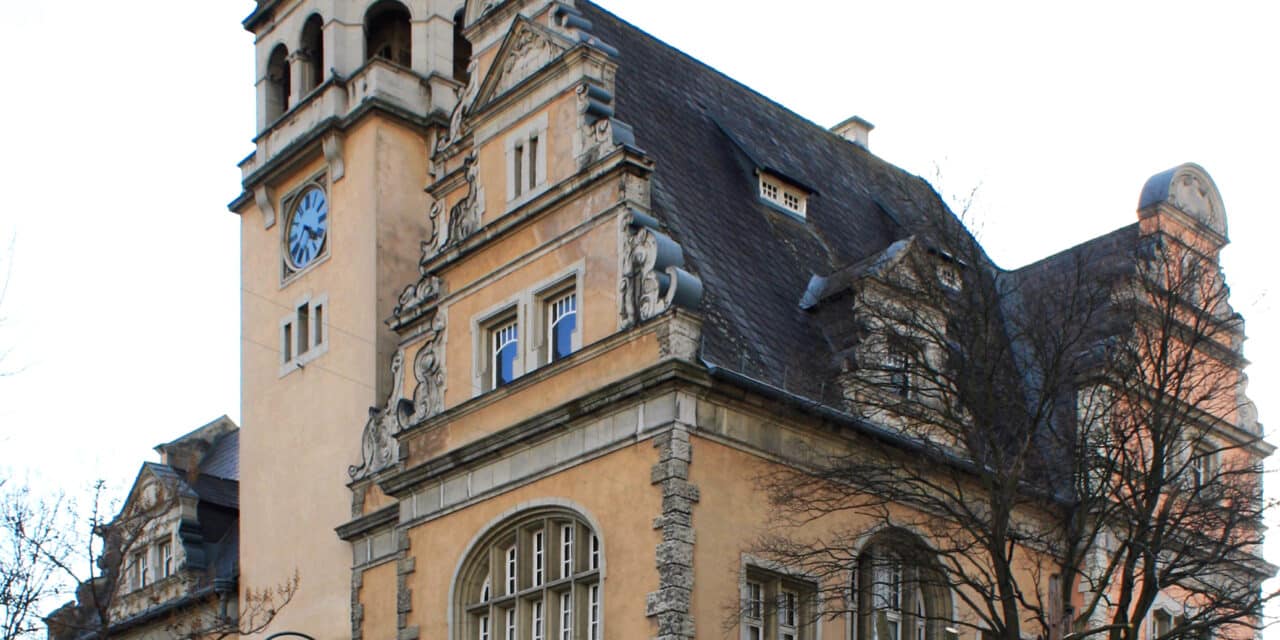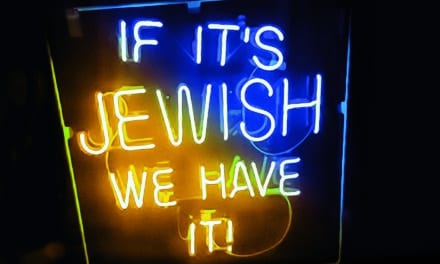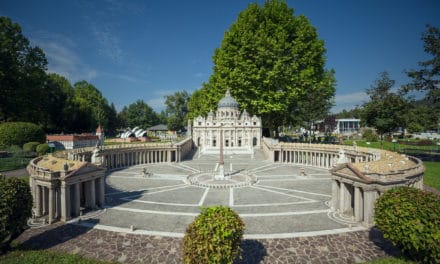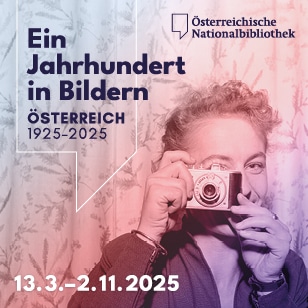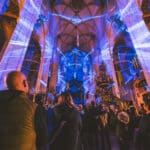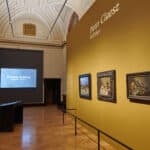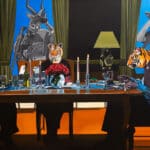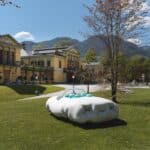Luckily, you have landed here at the Rollettmuseum Baden. However, this has nothing to do with the game of roulette, but with Anton Rollett, the founder of this museum. It is considered to be the oldest museum in Lower Austria. On an area of 350 square meters, you can experience the beginnings of Rollett's passion for collecting in the 19th century as well as the eventful history of the spa town of Baden. The building also houses the Baden town archives. The Baden town archive ensures the legal security of the town of Baden and its citizens. The documents taken over and stored in this context also document the history of this town.
The Rollett Cabinet. The "cabinet of curiosities" of the Baden doctor Anton Rollett (1778-1842) provides an insight into the excessive collecting and thirst for knowledge of the 19th century. On a smaller scale, a whole world of valuable and no less curious treasures opens up: boxes disguised as books containing plants collected and dried by Anton Rollett, snail kings and apothecary crocodiles, an ancient Egyptian mummy or souvenirs from Josef Frh. von Doblhoff's world tour, which were considered particularly "exotic" by his contemporaries.
What else there is to see: a travel pharmacy in miniature format, a 24-volume "collection of female handicrafts", an ancient Roman amphora, Anton Rollett's desk with a secret compartment, a rose from Archduke Carl's garden from Rollett's rose herbarium.
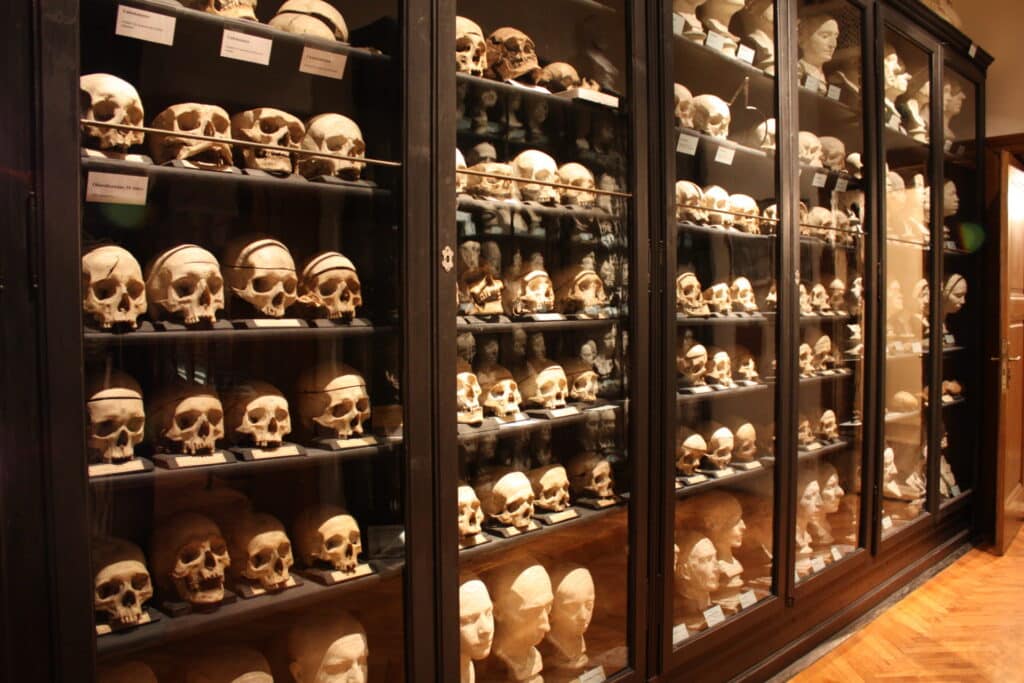
Rollettmuseum, Gallic skull collection © Rollettmuseum Baden
Uncanny realms: Gall's skull collection
The Rollett Museum's collection of skulls and busts houses the remains of the research of the doctor Franz Joseph Gall (1758-1828). Due to a misinterpretation, his theory of the brain gained questionable fame and he himself became a celebrated pop star. The hype went so far that European newspapers reported on veritable "cranial epidemics" after his lectures. The morbid collection was later expanded by Anton Rollett to include a collection of body casts, including a living mask of Napoleon Bonaparte.
What else there is to see: over 200 skulls and busts, wax replicas of human and animal brains in original size, Ferdinand Raimund's cast skullcap, a replica of Marie Antoinette's hand, a polar bear skull.
Early history - Neolithic Age, Metal Age, Roman bathing
Old acquaintances. A functional hammer, a delicate copper necklace or the familiar sound of a bone flute - the Neolithic finds from Baden's earliest settlement period around 5,000 years ago can explain why ancient history still fascinates people today: because we find ourselves in it when we take a closer look.
What else there is to see: the fashionable vessels of the Neolithic "Baden culture", stone weapons and tools, wild cats, weaving weights from the Hallstatt period, a Roman underfloor heating system, the polychrome gravestone of a Roman legionary, ceramics from Gaul.
Middle Ages
Castles, walls and loopholes. In 1480, Emperor Frederick III elevated Baden from a village to a town. This gave him the right to build a town wall, whose six gates were locked at night for security reasons. Most of the wine taverns were located outside the wall. To ensure that the people of Baden could continue to indulge in wine, an additional secret gate was quickly installed, which lived up to its name: the famous Lumpentürl. A glass "schnapps dog" suggests that alcohol consumption must have played a not insignificant role even in the days of the great knights' castles - merely to warm up on cold winter days, of course. After all, the heated bower was only allowed to be used by women and children...
What else there is to see: the wooden model of the town from 1900, stone cannonballs, skeletal remains from the mass grave in Archduchess Isabelle Street, coats of arms and seals, the fire flag of the Baden tower guard, a model of the Rauheneck hilltop castle.
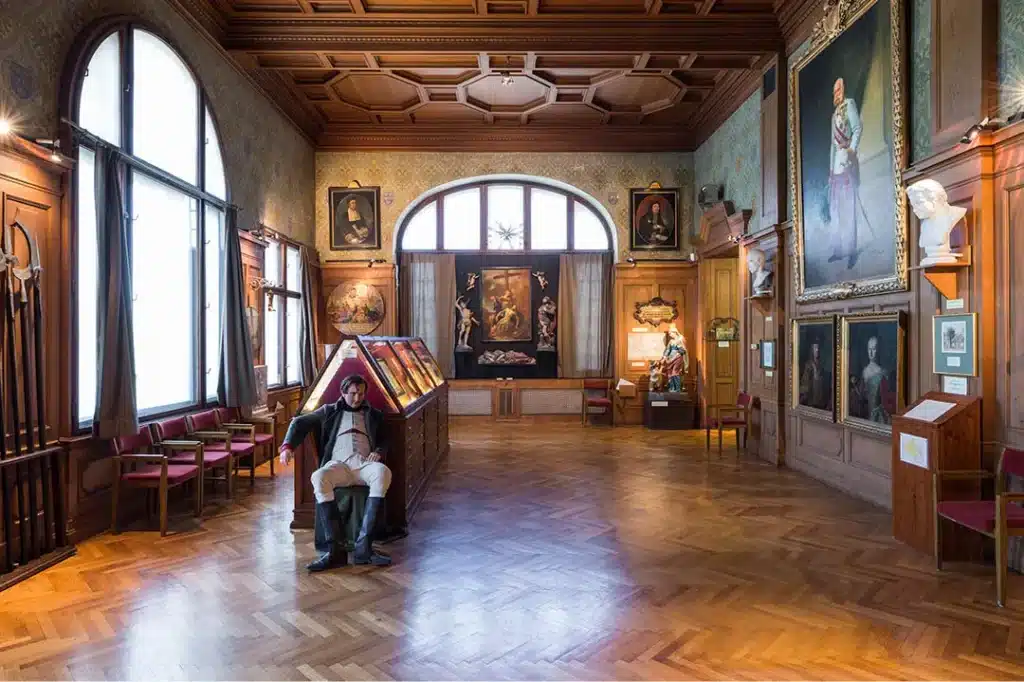
Rollettmuseum, medieval hall © Andreas Buchberger
Stages in the history of Baden
Difficult times. Documents and artifacts from various wars, epidemics and fires that Baden had to contend with between 1500 and 1800 show that the elevation of a town not only brought advantages, but also provided a target. Roughly speaking, every generation lost everything at least once. Incidentally, the city center "owes" its uniformly Biedermeier appearance to the last large-scale fire of 1812...
The exhibition room is the former meeting room of the town hall of the municipality of Weikersdorf, which became part of Baden in 1912.
What else there is to see: the town charter of Emperor Frederick III (replica), manipulable pennies, an old roll from Napoleonic times, halberds, the only surviving bust of Wolfgang Amadeus Mozart.
Springs and baths - the spa town of Baden
Health check in the old days. If you went to a spa in the 19th century, you naturally underwent a medical examination. Even then, it must have been perceived as a shameful matter to state one's own body weight. Why else would they have invented a scale with a mirror-inverted dial - "with built-in data protection", so to speak? At the same time, the spa business also produced equipment to promote positive body awareness, such as an underwater version of today's home trainer...
What else there is to see: Plans and diagrams of Baden's springs and thermal baths, a historic wheelchair, medicines from bygone eras, the town coat of arms that was too "obscene" for Empress Maria Theresa.
Biedermeier
Rich & beautiful. During the reign of Emperor Franz I, Baden's summer resorts flourished. The aim was to see and be seen. Plans of magnificently developed parks and gardens, paintings of women in lavish dresses according to the latest fashions and all kinds of artfully kitschy knick-knacks still bear witness today to the Biedermeier decadence of the wealthy classes of the early 19th century.
What else there is to see: a diorama of Weilburg Castle, Anton Rollett's oversized insect box, a playful nail set made of mother-of-pearl, porcelain souvenirs with Baden motifs and a multifunctional ironing board.
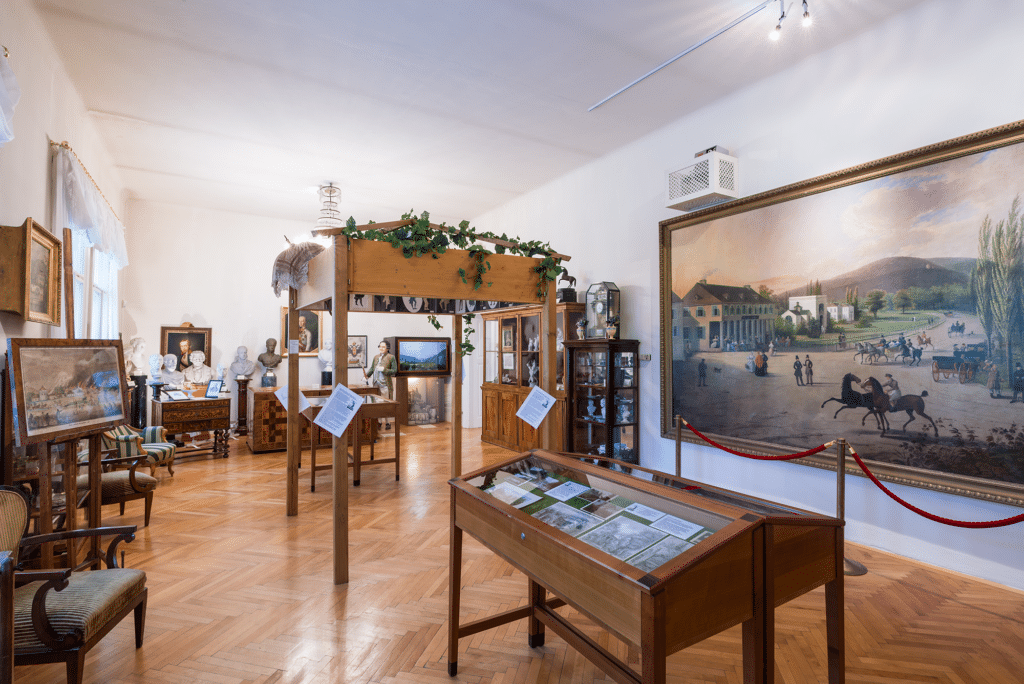
Rollett Museum, Biedermeier Hall © Andreas Buchberger
Viticulture
At the Heurigen. Wine has always been of great importance in Baden. This small room was donated by Mrs. Magda Riedl (1996) and provides a comprehensive documentation of the life of the grandparents' and great-grandparents' generation of Baden winegrowers. Not an archaeological sensation, but a touching insight into the lives of our ancestors.
What else there is to see: a Celtic vine knife made of iron and the "oldest vineyard snack in Baden", a piece of crockery rediscovered in the vineyards, around 400 years old.
Society in transition. Baden in the second half of the 19th century
From smoking and spitting and ... - the operetta. With the change from an aristocratic to an increasingly bourgeois spa clientele, Baden's cultural and industrial landscape also changed: Vistula plantations for the production of pipes were established, the railroad station was expanded and even an automobile factory was operated. Operettas and waltzes flourished. Rumour has it that one of the secrets of the success of the newly built summer arena was the lifting of the smoking ban - apparently an incentive for many men to accompany their wives to the theater... Incidentally, tobacco was not only smoked, but also chewed. A historical spittoon still bears witness to this peculiar physical technique.
What else there is to see: the bayonets and sabres of the national guard loyal to the emperor, a model of Gutenbrunn Castle, sheet music of famous Baden compositions.
Events up to 1955
History in pictures. Two paintings depicting the two world wars form a bracket for the formative war events in the first half of the 20th century. In 1917, Emperor Karl moved the army command from Teschen to Baden. The painter Carl Probst interpreted the associated hope of a possible peace treaty by depicting Emperor Karl and the Prussian Emperor Wilhelm II in reversed uniforms.
The gloomy painting from 1945 leaves little room for optimism: smoke and flames rise above Baden's alleyways, the sky is a menacing red. Baden was part of the Soviet occupation zone until 1955. Touching and frightening, an original letter from 1945 about the end of the war in Baden can be read in the display case. Read it here.
What else there is to see: a "double portrait" of Adolf Hitler and Andreas Hofer, artifacts from the Soviet occupation forces, a stereoscope with 3D photographs from around 1900, the state of the early lido and many rare photographs.
daily except Tuesday, 3 - 6 pm
Closed on December 24, 25, 26, 31 and January 1
www.rollettmuseum.at
Click on the button to load the content from rollettmuseum.at.

